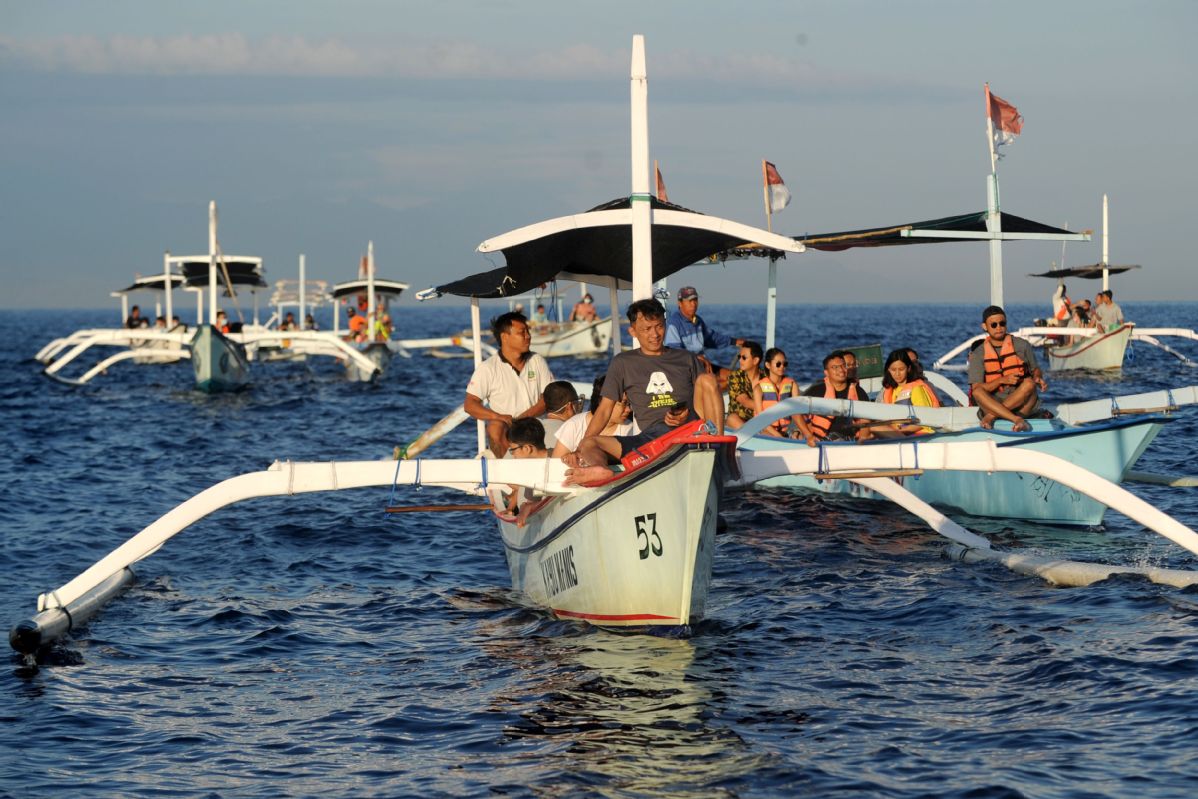
Tourists ride on boats modeled on a traditional style during a dolphin-watching excursion at sunrise off Bali’s Lovina Beach in Indonesia on Oct 30. SONNY TUMBELAKA/AGENCE FRANCE-PRESSE
BEIJING — While some Southeast Asian countries have gradually reopened their borders to foreign travelers, many feel that the region’s tourism industry has a way to go before it dispels the gloom brought by the COVID-19 pandemic on “a bumpy road” to recovery.
As part of encouraging moves in the region, Singapore is lifting border restrictions for visitors from the Chinese mainland from Friday, the city state’s authorities announced late last week. Visitors must take a COVID-19 test upon arrival and will not need to quarantine if they record a negative result.
Singapore’s move comes on the heels of Thailand welcoming the first batch of Chinese tourists under a special tourist visa program in late October. They were the first foreign arrivals in the tourism-reliant country in seven months.
The visa program was devised by the Thai authorities to restore, incrementally, a sector that by some estimates accounts for more than 10 percent of the country’s GDP, with almost 40 million visitors last year.
In Southeast Asia, Thailand is far from alone in having its tourism industry ravaged by the pandemic.
In Indonesia, the number of foreign visitors plunged more than 70 percent from January to September compared with the same period last year.
Cambodia also saw a huge slump in the number of foreign tourists during the first half of this year. The country welcomed just 1.18 million visitors for the six months, down 64 percent from the same period last year, Xinhua reported.
A strategy of gradual reopenings to foreign visitors is a good start for countries in Southeast Asia, and China stands out as a target source market for tourists with its record on coronavirus control, said Xu Liping, director of Southeast Asian studies at the Chinese Academy of Social Sciences.
Boosting cooperation
More importantly, Xu said the relaxations in travel restrictions for Chinese visitors represent a “gesture of regional cooperation with Asean countries amid the threat from COVID-19”.
Thailand was one of the top overseas destinations for Chinese tourists last year, accounting for by far the largest number of visitors by nationality. Some 11 million Chinese visitors put about $17 billion into the economy.
In a bid to lift its tourism industry out of the doldrums, Thailand plans further moves to open up.
Yuthasak Supasorn, governor of the Tourism Authority of Thailand, said the first phase of reopening will be limited to 1,200 people, a far cry from a monthly figure of around 3 million before the pandemic. The country is also mulling a cut in the mandatory quarantine to 10 days, from 14 days.
For Wang Min, a 32-year-old office worker in Beijing, word about Thailand’s special tourist visa comes as welcome news. Like many others who have not been able to travel abroad, she’s been looking forward to do so once tourism resumes.
“I planned to spend Spring Festival holiday in Thailand in January this year but didn’t make it because of the pandemic. I can’t help dreaming of strolling the streets and devouring the tasty food there.”
But for Wang, who loves to travel, the cost of a 14-day quarantine is not affordable-in money and time. It’s also a risk to travel abroad when the world is still in the grip of COVID-19, Wang said.
There is another difficulty-the limited number of flights to Thailand, with just a few from China every week, and only one nonstop flight from Shanghai to Bangkok.
A full revival of tourism in Southeast Asian nations is some way off, Xu said. “Southeast Asia’s tourism sector is still facing a bumpy road ahead. It all depends on the situation with the epidemic,” he said.